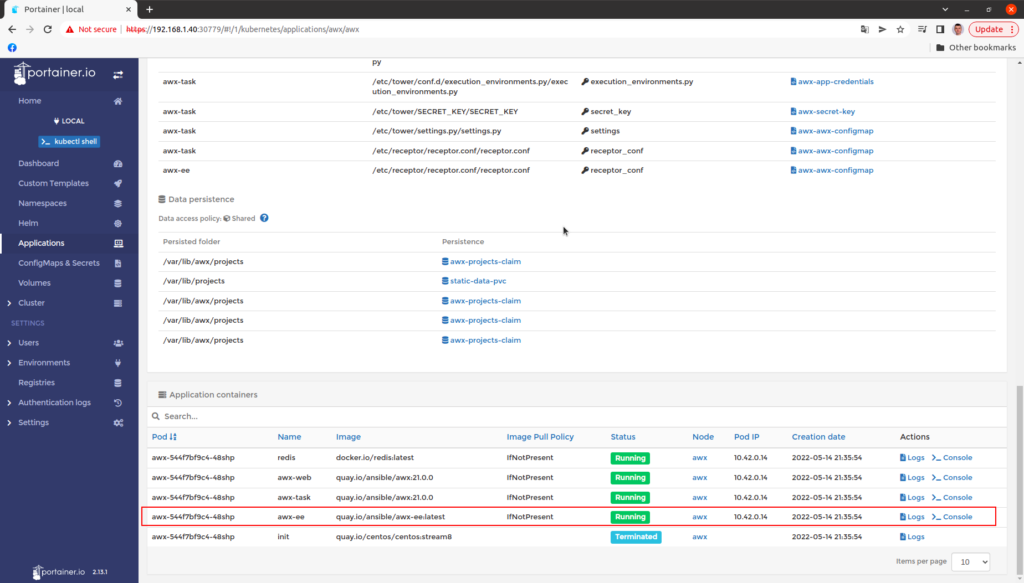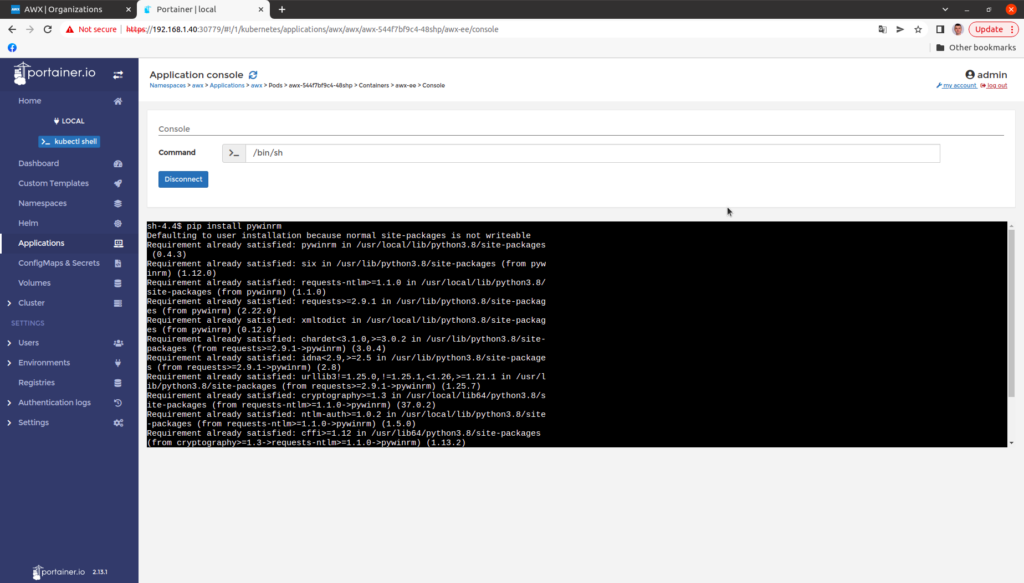Merhaba, İlk iki yazımızda AWX Ansbile kurulumu yapmış ve sonra ki makalede temel konfigürasyonlara bakmıştık. Bu makalede konfigürasyon işlemlerine devam ediyoruz.
https://www.cozumpark.com/awx-ansible-kurulumu
https://www.cozumpark.com/awx-ansible-temel-konfigurasyon-bolum-1
İkinci makalede Linux sistemlere erişimler üzerinde durmuştuk. Bu makalede ise Windows sistemlere erişiminler üzerinde duracağız.
İlk olarak yine Portainer’ı açarak “awx-ee” pod’una bağlanıyoruz.

Windows sistemlere erişim için “pywinrm“‘i kurmamız gerekiyor. Bu Windows sistemler ile iletişimimizi sağlayacak.
pip install pywinrm
Bir adet Windows 10 makinem var. Windows tarafında ise yapmamız gereken WinRM erişimini açmak. Ansbile, Windows sistemlere WinRM üzerinden erişiyor bu yüzden aşağıdaki powershell script’ini kopyalayıp “ps1” uzantılı kaydedip ve Windows sistem üzerinde çalıştırmanız gerekiyor.
Not: Windows firewall üzerinde 5985 ve 5986 portları açmanız gerekiyor.
#Requires -Version 3.0
# Configure a Windows host for remote management with Ansible
# -----------------------------------------------------------
#
# This script checks the current WinRM (PS Remoting) configuration and makes
# the necessary changes to allow Ansible to connect, authenticate and
# execute PowerShell commands.
#
# All events are logged to the Windows EventLog, useful for unattended runs.
#
# Use option -Verbose in order to see the verbose output messages.
#
# Use option -CertValidityDays to specify how long this certificate is valid
# starting from today. So you would specify -CertValidityDays 3650 to get
# a 10-year valid certificate.
#
# Use option -ForceNewSSLCert if the system has been SysPreped and a new
# SSL Certificate must be forced on the WinRM Listener when re-running this
# script. This is necessary when a new SID and CN name is created.
#
# Use option -EnableCredSSP to enable CredSSP as an authentication option.
#
# Use option -DisableBasicAuth to disable basic authentication.
#
# Use option -SkipNetworkProfileCheck to skip the network profile check.
# Without specifying this the script will only run if the device's interfaces
# are in DOMAIN or PRIVATE zones. Provide this switch if you want to enable
# WinRM on a device with an interface in PUBLIC zone.
#
# Use option -SubjectName to specify the CN name of the certificate. This
# defaults to the system's hostname and generally should not be specified.
# Written by Trond Hindenes <trond@hindenes.com>
# Updated by Chris Church <cchurch@ansible.com>
# Updated by Michael Crilly <mike@autologic.cm>
# Updated by Anton Ouzounov <Anton.Ouzounov@careerbuilder.com>
# Updated by Nicolas Simond <contact@nicolas-simond.com>
# Updated by Dag Wieërs <dag@wieers.com>
# Updated by Jordan Borean <jborean93@gmail.com>
# Updated by Erwan Quélin <erwan.quelin@gmail.com>
# Updated by David Norman <david@dkn.email>
#
# Version 1.0 - 2014-07-06
# Version 1.1 - 2014-11-11
# Version 1.2 - 2015-05-15
# Version 1.3 - 2016-04-04
# Version 1.4 - 2017-01-05
# Version 1.5 - 2017-02-09
# Version 1.6 - 2017-04-18
# Version 1.7 - 2017-11-23
# Version 1.8 - 2018-02-23
# Version 1.9 - 2018-09-21
# Support -Verbose option
[CmdletBinding()]
Param (
[string]$SubjectName = $env:COMPUTERNAME,
[int]$CertValidityDays = 1095,
[switch]$SkipNetworkProfileCheck,
$CreateSelfSignedCert = $true,
[switch]$ForceNewSSLCert,
[switch]$GlobalHttpFirewallAccess,
[switch]$DisableBasicAuth = $false,
[switch]$EnableCredSSP
)
Function Write-ProgressLog {
$Message = $args[0]
Write-EventLog -LogName Application -Source $EventSource -EntryType Information -EventId 1 -Message $Message
}
Function Write-VerboseLog {
$Message = $args[0]
Write-Verbose $Message
Write-ProgressLog $Message
}
Function Write-HostLog {
$Message = $args[0]
Write-Output $Message
Write-ProgressLog $Message
}
Function New-LegacySelfSignedCert {
Param (
[string]$SubjectName,
[int]$ValidDays = 1095
)
$hostnonFQDN = $env:computerName
$hostFQDN = [System.Net.Dns]::GetHostByName(($env:computerName)).Hostname
$SignatureAlgorithm = "SHA256"
$name = New-Object -COM "X509Enrollment.CX500DistinguishedName.1"
$name.Encode("CN=$SubjectName", 0)
$key = New-Object -COM "X509Enrollment.CX509PrivateKey.1"
$key.ProviderName = "Microsoft Enhanced RSA and AES Cryptographic Provider"
$key.KeySpec = 1
$key.Length = 4096
$key.SecurityDescriptor = "D:PAI(A;;0xd01f01ff;;;SY)(A;;0xd01f01ff;;;BA)(A;;0x80120089;;;NS)"
$key.MachineContext = 1
$key.Create()
$serverauthoid = New-Object -COM "X509Enrollment.CObjectId.1"
$serverauthoid.InitializeFromValue("1.3.6.1.5.5.7.3.1")
$ekuoids = New-Object -COM "X509Enrollment.CObjectIds.1"
$ekuoids.Add($serverauthoid)
$ekuext = New-Object -COM "X509Enrollment.CX509ExtensionEnhancedKeyUsage.1"
$ekuext.InitializeEncode($ekuoids)
$cert = New-Object -COM "X509Enrollment.CX509CertificateRequestCertificate.1"
$cert.InitializeFromPrivateKey(2, $key, "")
$cert.Subject = $name
$cert.Issuer = $cert.Subject
$cert.NotBefore = (Get-Date).AddDays(-1)
$cert.NotAfter = $cert.NotBefore.AddDays($ValidDays)
$SigOID = New-Object -ComObject X509Enrollment.CObjectId
$SigOID.InitializeFromValue(([Security.Cryptography.Oid]$SignatureAlgorithm).Value)
[string[]] $AlternativeName += $hostnonFQDN
$AlternativeName += $hostFQDN
$IAlternativeNames = New-Object -ComObject X509Enrollment.CAlternativeNames
foreach ($AN in $AlternativeName) {
$AltName = New-Object -ComObject X509Enrollment.CAlternativeName
$AltName.InitializeFromString(0x3, $AN)
$IAlternativeNames.Add($AltName)
}
$SubjectAlternativeName = New-Object -ComObject X509Enrollment.CX509ExtensionAlternativeNames
$SubjectAlternativeName.InitializeEncode($IAlternativeNames)
[String[]]$KeyUsage = ("DigitalSignature", "KeyEncipherment")
$KeyUsageObj = New-Object -ComObject X509Enrollment.CX509ExtensionKeyUsage
$KeyUsageObj.InitializeEncode([int][Security.Cryptography.X509Certificates.X509KeyUsageFlags]($KeyUsage))
$KeyUsageObj.Critical = $true
$cert.X509Extensions.Add($KeyUsageObj)
$cert.X509Extensions.Add($ekuext)
$cert.SignatureInformation.HashAlgorithm = $SigOID
$CERT.X509Extensions.Add($SubjectAlternativeName)
$cert.Encode()
$enrollment = New-Object -COM "X509Enrollment.CX509Enrollment.1"
$enrollment.InitializeFromRequest($cert)
$certdata = $enrollment.CreateRequest(0)
$enrollment.InstallResponse(2, $certdata, 0, "")
# extract/return the thumbprint from the generated cert
$parsed_cert = New-Object System.Security.Cryptography.X509Certificates.X509Certificate2
$parsed_cert.Import([System.Text.Encoding]::UTF8.GetBytes($certdata))
return $parsed_cert.Thumbprint
}
Function Enable-GlobalHttpFirewallAccess {
Write-Verbose "Forcing global HTTP firewall access"
# this is a fairly naive implementation; could be more sophisticated about rule matching/collapsing
$fw = New-Object -ComObject HNetCfg.FWPolicy2
# try to find/enable the default rule first
$add_rule = $false
$matching_rules = $fw.Rules | Where-Object { $_.Name -eq "Windows Remote Management (HTTP-In)" }
$rule = $null
If ($matching_rules) {
If ($matching_rules -isnot [Array]) {
Write-Verbose "Editing existing single HTTP firewall rule"
$rule = $matching_rules
}
Else {
# try to find one with the All or Public profile first
Write-Verbose "Found multiple existing HTTP firewall rules..."
$rule = $matching_rules | ForEach-Object { $_.Profiles -band 4 }[0]
If (-not $rule -or $rule -is [Array]) {
Write-Verbose "Editing an arbitrary single HTTP firewall rule (multiple existed)"
# oh well, just pick the first one
$rule = $matching_rules[0]
}
}
}
If (-not $rule) {
Write-Verbose "Creating a new HTTP firewall rule"
$rule = New-Object -ComObject HNetCfg.FWRule
$rule.Name = "Windows Remote Management (HTTP-In)"
$rule.Description = "Inbound rule for Windows Remote Management via WS-Management. [TCP 5985]"
$add_rule = $true
}
$rule.Profiles = 0x7FFFFFFF
$rule.Protocol = 6
$rule.LocalPorts = 5985
$rule.RemotePorts = "*"
$rule.LocalAddresses = "*"
$rule.RemoteAddresses = "*"
$rule.Enabled = $true
$rule.Direction = 1
$rule.Action = 1
$rule.Grouping = "Windows Remote Management"
If ($add_rule) {
$fw.Rules.Add($rule)
}
Write-Verbose "HTTP firewall rule $($rule.Name) updated"
}
# Setup error handling.
Trap {
$_
Exit 1
}
$ErrorActionPreference = "Stop"
# Get the ID and security principal of the current user account
$myWindowsID = [System.Security.Principal.WindowsIdentity]::GetCurrent()
$myWindowsPrincipal = new-object System.Security.Principal.WindowsPrincipal($myWindowsID)
# Get the security principal for the Administrator role
$adminRole = [System.Security.Principal.WindowsBuiltInRole]::Administrator
# Check to see if we are currently running "as Administrator"
if (-Not $myWindowsPrincipal.IsInRole($adminRole)) {
Write-Output "ERROR: You need elevated Administrator privileges in order to run this script."
Write-Output " Start Windows PowerShell by using the Run as Administrator option."
Exit 2
}
$EventSource = $MyInvocation.MyCommand.Name
If (-Not $EventSource) {
$EventSource = "Powershell CLI"
}
If ([System.Diagnostics.EventLog]::Exists('Application') -eq $False -or [System.Diagnostics.EventLog]::SourceExists($EventSource) -eq $False) {
New-EventLog -LogName Application -Source $EventSource
}
# Detect PowerShell version.
If ($PSVersionTable.PSVersion.Major -lt 3) {
Write-ProgressLog "PowerShell version 3 or higher is required."
Throw "PowerShell version 3 or higher is required."
}
# Find and start the WinRM service.
Write-Verbose "Verifying WinRM service."
If (!(Get-Service "WinRM")) {
Write-ProgressLog "Unable to find the WinRM service."
Throw "Unable to find the WinRM service."
}
ElseIf ((Get-Service "WinRM").Status -ne "Running") {
Write-Verbose "Setting WinRM service to start automatically on boot."
Set-Service -Name "WinRM" -StartupType Automatic
Write-ProgressLog "Set WinRM service to start automatically on boot."
Write-Verbose "Starting WinRM service."
Start-Service -Name "WinRM" -ErrorAction Stop
Write-ProgressLog "Started WinRM service."
}
# WinRM should be running; check that we have a PS session config.
If (!(Get-PSSessionConfiguration -Verbose:$false) -or (!(Get-ChildItem WSMan:\localhost\Listener))) {
If ($SkipNetworkProfileCheck) {
Write-Verbose "Enabling PS Remoting without checking Network profile."
Enable-PSRemoting -SkipNetworkProfileCheck -Force -ErrorAction Stop
Write-ProgressLog "Enabled PS Remoting without checking Network profile."
}
Else {
Write-Verbose "Enabling PS Remoting."
Enable-PSRemoting -Force -ErrorAction Stop
Write-ProgressLog "Enabled PS Remoting."
}
}
Else {
Write-Verbose "PS Remoting is already enabled."
}
# Ensure LocalAccountTokenFilterPolicy is set to 1
# https://github.com/ansible/ansible/issues/42978
$token_path = "HKLM:\SOFTWARE\Microsoft\Windows\CurrentVersion\Policies\System"
$token_prop_name = "LocalAccountTokenFilterPolicy"
$token_key = Get-Item -Path $token_path
$token_value = $token_key.GetValue($token_prop_name, $null)
if ($token_value -ne 1) {
Write-Verbose "Setting LocalAccountTOkenFilterPolicy to 1"
if ($null -ne $token_value) {
Remove-ItemProperty -Path $token_path -Name $token_prop_name
}
New-ItemProperty -Path $token_path -Name $token_prop_name -Value 1 -PropertyType DWORD > $null
}
# Make sure there is a SSL listener.
$listeners = Get-ChildItem WSMan:\localhost\Listener
If (!($listeners | Where-Object { $_.Keys -like "TRANSPORT=HTTPS" })) {
# We cannot use New-SelfSignedCertificate on 2012R2 and earlier
$thumbprint = New-LegacySelfSignedCert -SubjectName $SubjectName -ValidDays $CertValidityDays
Write-HostLog "Self-signed SSL certificate generated; thumbprint: $thumbprint"
# Create the hashtables of settings to be used.
$valueset = @{
Hostname = $SubjectName
CertificateThumbprint = $thumbprint
}
$selectorset = @{
Transport = "HTTPS"
Address = "*"
}
Write-Verbose "Enabling SSL listener."
New-WSManInstance -ResourceURI 'winrm/config/Listener' -SelectorSet $selectorset -ValueSet $valueset
Write-ProgressLog "Enabled SSL listener."
}
Else {
Write-Verbose "SSL listener is already active."
# Force a new SSL cert on Listener if the $ForceNewSSLCert
If ($ForceNewSSLCert) {
# We cannot use New-SelfSignedCertificate on 2012R2 and earlier
$thumbprint = New-LegacySelfSignedCert -SubjectName $SubjectName -ValidDays $CertValidityDays
Write-HostLog "Self-signed SSL certificate generated; thumbprint: $thumbprint"
$valueset = @{
CertificateThumbprint = $thumbprint
Hostname = $SubjectName
}
# Delete the listener for SSL
$selectorset = @{
Address = "*"
Transport = "HTTPS"
}
Remove-WSManInstance -ResourceURI 'winrm/config/Listener' -SelectorSet $selectorset
# Add new Listener with new SSL cert
New-WSManInstance -ResourceURI 'winrm/config/Listener' -SelectorSet $selectorset -ValueSet $valueset
}
}
# Check for basic authentication.
$basicAuthSetting = Get-ChildItem WSMan:\localhost\Service\Auth | Where-Object { $_.Name -eq "Basic" }
If ($DisableBasicAuth) {
If (($basicAuthSetting.Value) -eq $true) {
Write-Verbose "Disabling basic auth support."
Set-Item -Path "WSMan:\localhost\Service\Auth\Basic" -Value $false
Write-ProgressLog "Disabled basic auth support."
}
Else {
Write-Verbose "Basic auth is already disabled."
}
}
Else {
If (($basicAuthSetting.Value) -eq $false) {
Write-Verbose "Enabling basic auth support."
Set-Item -Path "WSMan:\localhost\Service\Auth\Basic" -Value $true
Write-ProgressLog "Enabled basic auth support."
}
Else {
Write-Verbose "Basic auth is already enabled."
}
}
# If EnableCredSSP if set to true
If ($EnableCredSSP) {
# Check for CredSSP authentication
$credsspAuthSetting = Get-ChildItem WSMan:\localhost\Service\Auth | Where-Object { $_.Name -eq "CredSSP" }
If (($credsspAuthSetting.Value) -eq $false) {
Write-Verbose "Enabling CredSSP auth support."
Enable-WSManCredSSP -role server -Force
Write-ProgressLog "Enabled CredSSP auth support."
}
}
If ($GlobalHttpFirewallAccess) {
Enable-GlobalHttpFirewallAccess
}
# Configure firewall to allow WinRM HTTPS connections.
$fwtest1 = netsh advfirewall firewall show rule name="Allow WinRM HTTPS"
$fwtest2 = netsh advfirewall firewall show rule name="Allow WinRM HTTPS" profile=any
If ($fwtest1.count -lt 5) {
Write-Verbose "Adding firewall rule to allow WinRM HTTPS."
netsh advfirewall firewall add rule profile=any name="Allow WinRM HTTPS" dir=in localport=5986 protocol=TCP action=allow
Write-ProgressLog "Added firewall rule to allow WinRM HTTPS."
}
ElseIf (($fwtest1.count -ge 5) -and ($fwtest2.count -lt 5)) {
Write-Verbose "Updating firewall rule to allow WinRM HTTPS for any profile."
netsh advfirewall firewall set rule name="Allow WinRM HTTPS" new profile=any
Write-ProgressLog "Updated firewall rule to allow WinRM HTTPS for any profile."
}
Else {
Write-Verbose "Firewall rule already exists to allow WinRM HTTPS."
}
# Test a remoting connection to localhost, which should work.
$httpResult = Invoke-Command -ComputerName "localhost" -ScriptBlock { $using:env:COMPUTERNAME } -ErrorVariable httpError -ErrorAction SilentlyContinue
$httpsOptions = New-PSSessionOption -SkipCACheck -SkipCNCheck -SkipRevocationCheck
$httpsResult = New-PSSession -UseSSL -ComputerName "localhost" -SessionOption $httpsOptions -ErrorVariable httpsError -ErrorAction SilentlyContinue
If ($httpResult -and $httpsResult) {
Write-Verbose "HTTP: Enabled | HTTPS: Enabled"
}
ElseIf ($httpsResult -and !$httpResult) {
Write-Verbose "HTTP: Disabled | HTTPS: Enabled"
}
ElseIf ($httpResult -and !$httpsResult) {
Write-Verbose "HTTP: Enabled | HTTPS: Disabled"
}
Else {
Write-ProgressLog "Unable to establish an HTTP or HTTPS remoting session."
Throw "Unable to establish an HTTP or HTTPS remoting session."
}
Write-VerboseLog "PS Remoting has been successfully configured for Ansible."Bu işlemin ardında, Windows sistemlere erişimin için yeni bir Credentials oluşturuyoruz. Bu makalede erişim yaptığımız Windows, Workgroup’da çalışmakta bu yüzden Windows üzerindeki kullanıcı hesabıma bir şifre tanımladım ve bu erişim bilgilerini aşağıda görüldüğü gibi tanımladım.
Bu işlemin ardından yeni bir “Inventory” oluşturuyorum ve “Variables” kısmına aşağıdaki bilgileri giriyorum. Bunlar erişim için gerekli.
ansible_port: 5986
ansible_connection: winrm
ansible_winrm_server_cert_validation: ignoreSonrasında Host tabına gerek “Run command” butonuna taklıyorum.
Module listesinden “win_ping“‘i seçiyorum.
Daha önce oluşturduğım “Credentials” olan “cred_windows“‘ı seçip devam ediyoruz.
Son olarak “Launch” tıklayarak çalıştırıyoruz. Görüldüğü gibi Windows sisteme bağlandık ve sistemi ping’ledik.
Bu makale ile beraber Linux ve Windows sistemlere bağlantı şekillerini gördük. Bir sonra ki makalede Domain ortamında olan bir Windows sisteme erişimi inceleyeceğiz. Keyifli okumalar, sağlıcakla kalın.
